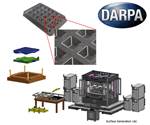DARPA dubs new hybrid-electric X-plane XRG-73
Scaled Composites, Cornerstone Research Group and others are supplying the uncrewed aircraft, which will mature a long-endurance aircraft design.
Source | DARPA
The (DARPA, Arlington, Va., U.S.) has assigned the designation XRQ-73 to its Series Hybrid Electric Propulsion AiRcraft Demonstration (SHEPARD) hybrid-electric uncrewed aircraft system.
SHEPARD is an “X-prime” program, leveraging the series hybrid-electric architecture and some of the component technologies from the earlier , which sought to extend the operational endurance and payload capabilities for intelligence surveillance and reconnaissance (ISR) unmanned aerial vehicles (UAVs).
“The idea behind a DARPA X-prime program is to take emerging technologies and burn down system-level integration risks to quickly mature a new missionized long-endurance aircraft design that can be fielded quickly,” says Steve Komadina, SHEPARD program manager. “The SHEPARD program is maturing a specific propulsion architecture and power class as an exemplar of potential benefits for the Department of Defense.”
The DARPA team includes members from the Air Force Research Laboratory (AFRL), the Office of Naval Research (ONR) and warfighters.
The prime contractor for SHEPARD is Northrop Grumman Corp.’s Aeronautics Systems (Redondo Beach, Calif., U.S.) sector. Aerospace and composites R&D company Scaled Composites LLC (Mojave) is a major supplier, along with Cornerstone Research Group Inc., Brayton Energy LLC, PC Krause and Associates and EaglePicher Technologies LLC.
The XRQ-73 aircraft will be a Group 3 UAS weighing approximately 1,250 pounds. First flight of the XRQ-73 is expected by year-end 2024.
For related content, read “DARPA shows concepts for future VTOL uncrewed aerial systems.”
Related Content
-
Scaled Composites Model 437 aircraft to be flown for Beacon autonomy testbed
Northrop Grumman subsidiary part of Digital Pathfinder development of stealth aircraft with wings using continuous carbon fiber additive manufacturing and determinate assembly.
-
Industrializing additive manufacturing in the defense/aerospace sector
GA-ASI demonstrates a path forward for the use of additive technologies for composite tooling, flight-qualified parts.
-
Syensqo composites demonstrate titanium replacement on Boeing MQ-25 Stingray
Validation of integrating Cycom 5250-4HT prepreg into the UAV’s exhaust nozzle structure underpins the material system’s use in other high-temperature aerospace applications.






